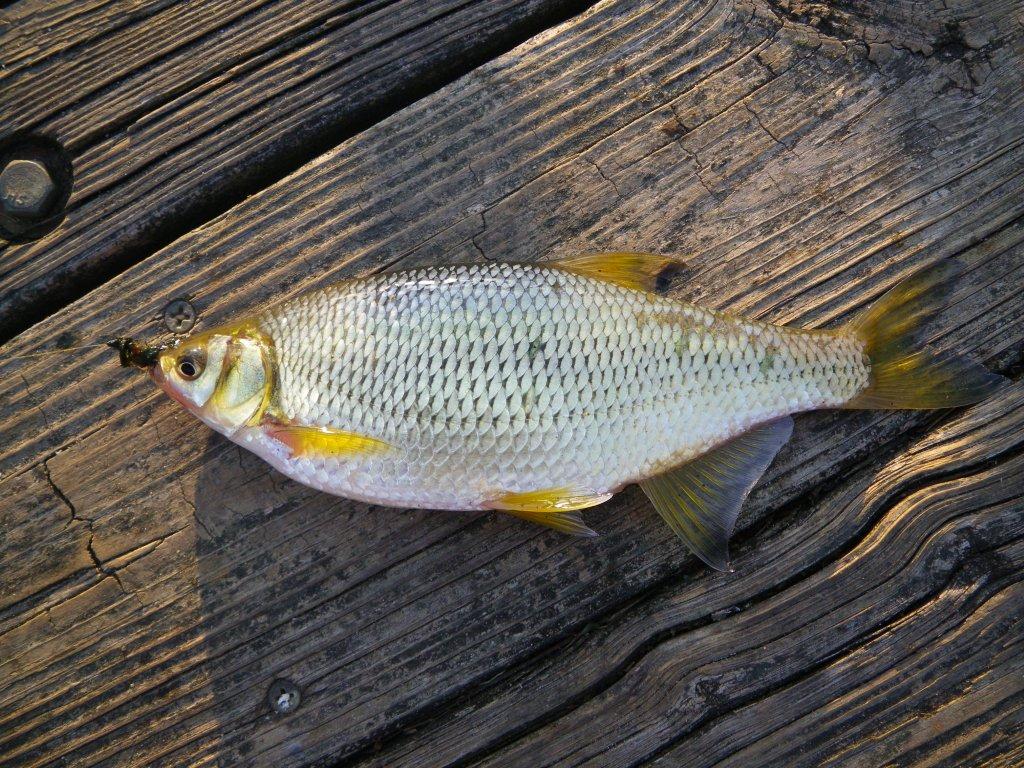Is this a Golden Shiner?
#4
 Guest_smbass_*
Guest_smbass_*
Posted 19 March 2010 - 10:17 PM
#5
 Guest_FirstChAoS_*
Guest_FirstChAoS_*
Posted 19 March 2010 - 10:40 PM
Is this a Golden Shiner? They are all over a local pond, but I only catch them in spring. Not sure where they go the rest of the year, or how they manage to avoid being tasty bass-candy since there are no weeds to hide in.
Hmmm, spade shaped body, pointed sharky dorsal fin, ability to take over ponds (to the point i call them "pond roaches" at times) all points to golden shiner. Seeing one with actual golden coloration on it is rare but it does happen.
It also lacks the black spot on its side all the pictures of threadfin shad I can find seem to have.
Edited by FirstChAoS, 19 March 2010 - 10:44 PM.
#7
 Guest_Casper Cox_*
Guest_Casper Cox_*
Posted 23 March 2010 - 02:09 PM
Golden Shiners have a keel on their front breast. A unique feature. There are some at the TN Aquarium that are about 12" long. Very flowing fins. I have one in the cement pond that is approaching that size. 2 others are from Florida and sport the red tails. The red is now subdued from when i first caught them, blood red, in a Tates Hell ditch. They can be small and have those red fins. Ive also seen them in spring heads so they can vary in both habitat and temperature.
I wonder if there is any talk about splitting them as a subspecies?
I raised a bunch of fry once and i think they make nice aquarium fish, especially for a beginner.
A common bait bucket specie from my area. That and Fatheads or toughies as they call them.
Casper
#9
 Guest_gerald_*
Guest_gerald_*
Posted 24 March 2010 - 09:51 AM
BTW, ive always wondered why does "crysoleucas" NOT have an "h" like every other critter with "chryso-" in its name? Was this just a typo in the original description?
I believe that rudd have been introduced into parts of MD. Could be this.
Edited by gerald, 24 March 2010 - 09:55 AM.
#10
 Guest_Newt_*
Guest_Newt_*
Posted 24 March 2010 - 10:42 AM
BTW, ive always wondered why does "crysoleucas" NOT have an "h" like every other critter with "chryso-" in its name? Was this just a typo in the original description?
Yes. In the pre-ICZN days, many authors would "correct" the spelling of names, either to eliminate a typo or just to change it to a more preferred spelling, which led to a profusion of junior synonyms. For example, some herpetological authors felt that names derived from Greek should be properly Latinized rather than merely transliterated, so the snake genus Agkistrodon was often corrected to "Ancistrodon". Part of the function of ICZN is to put a stop to that sort of thing. The published name, mis-spelled or not, is official.
Reply to this topic
1 user(s) are reading this topic
0 members, 1 guests, 0 anonymous users








